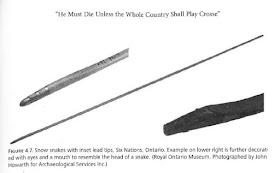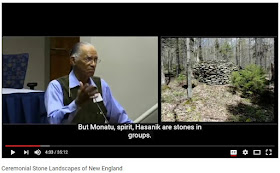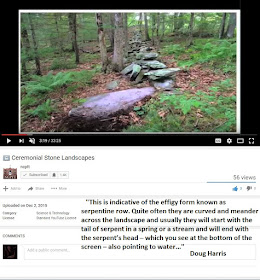"You're not in Scotland (England and Ireland) Anymore")
Interesting
photo, a round entrance into a "Stone Chamber:"
I’ve got this idea
that the entrance to many “mysterious chambers” are actually very much a
representation of a Timber Rattlesnake’s eye, sometimes but not all the time
surrounded by stones that look very much like the scales around the eye of the snake
that serves as the model for the Great or Horned Serpent. This shape - and it's size - makes me think of a person crawling into the small entrance of a sweat lodge as well...
“Which one is it?”
I wonder – then, with a couple clicks of my mouse, I find myself looking Mary and James Gage’s Stone Structures page
on their website: “Monks” Chamber http://www.stonestructures.org/html/shutesbury_-_chamber_1.html - and I think "Thanks again Mary and James, you made another question very easy to answer."
I search for some
similar images, click away and end up here:
Below the photo it says:
Monks Cave
“Scattered all across New England, the debate still rages...monks
caves as a monument to a bygone era when missionary monks from Ireland came to
the new country? Or they as simple as colonial cellar holes? No one seems to
hold the answer to this, but they're fascinating nonetheless!”
(No mention of Indigenous People is made, despite the fact
that they’ve been around the area for more than 10,000 years. No mention made
of the widespread use of Sweat lodges/Pesuponcks often mentioning Medicine
People and Great Serpents that are recalled in numerous Indigenous stories all
across Turtle Island, many of them collected here on this blog...)
I look for a few more images, stumble on somebody’s
monetized web-site, hawking his numerous books and sporting all sorts of ads
for other stuff as well.
Briefly mentioning
the Ancient Geeks, the author of the books for sale repeats a statement I hear
often, “The New England chambers are dead ringers for those built by the Culdee
Monks of Scotland, England, and Ireland who adopted the building style from
their Celtic ancestry.”
“And which ones
would those be?” I wonder, highlighting the sentence and searching Google
images for a possible example. I’ll be durned if I can find one that looks anything close to a “ringer,”
living or dead, coming up with examples of the Behive Chambers associated with the Culdee Monks.
Enter "Sweat House" or "Sauna" and you get examples of similar structures our whole Human Family has made all around this big blue world. If you ignore those found in the Western Hemisphere, I think your well rounded research might be just a little less than perfectly round...













































